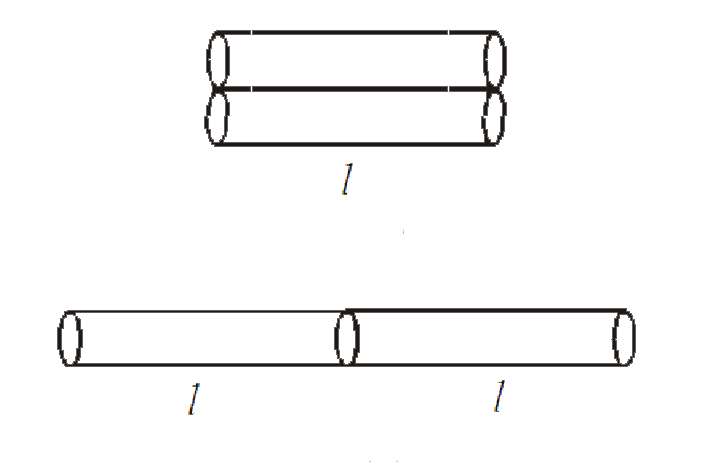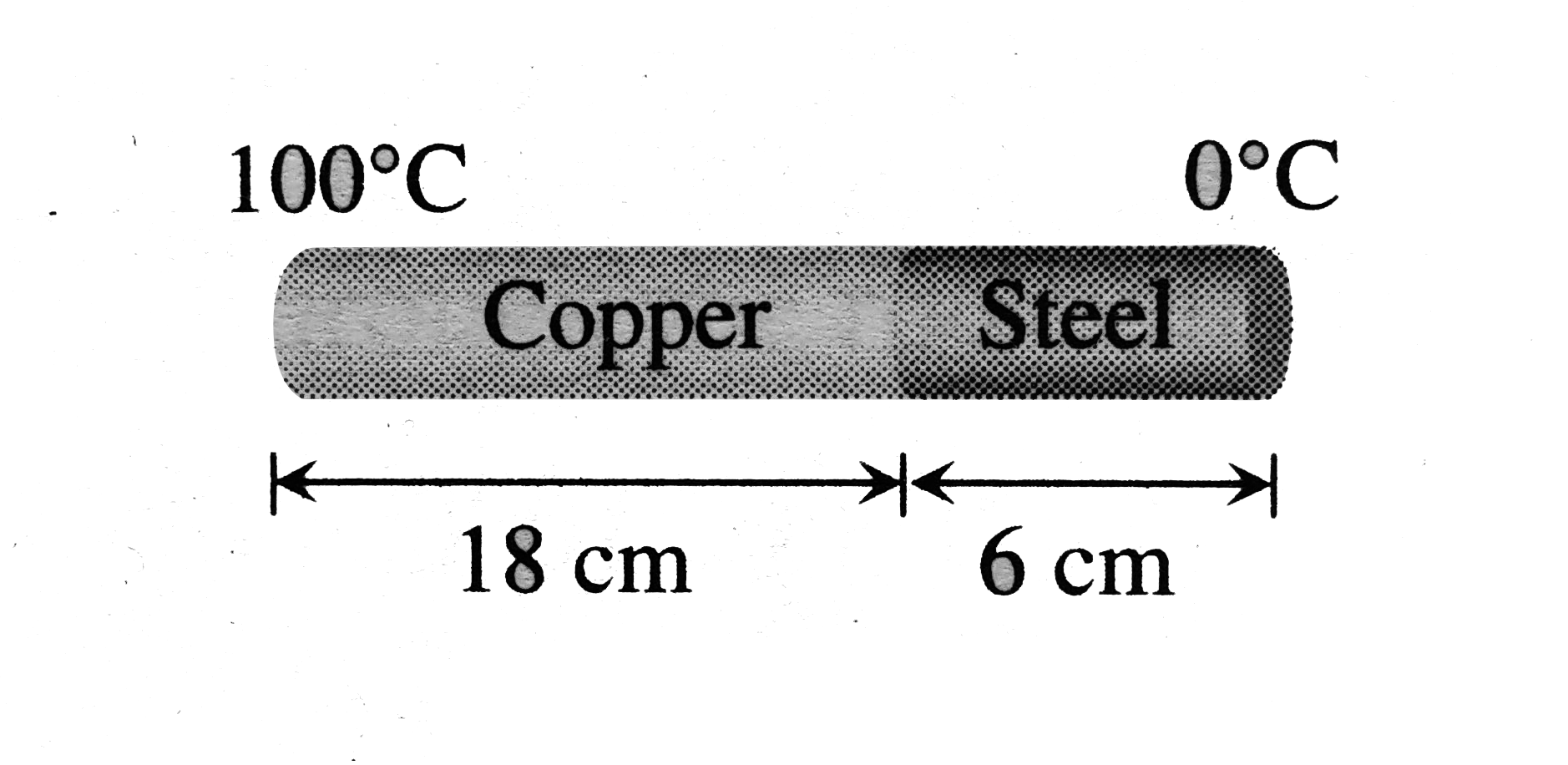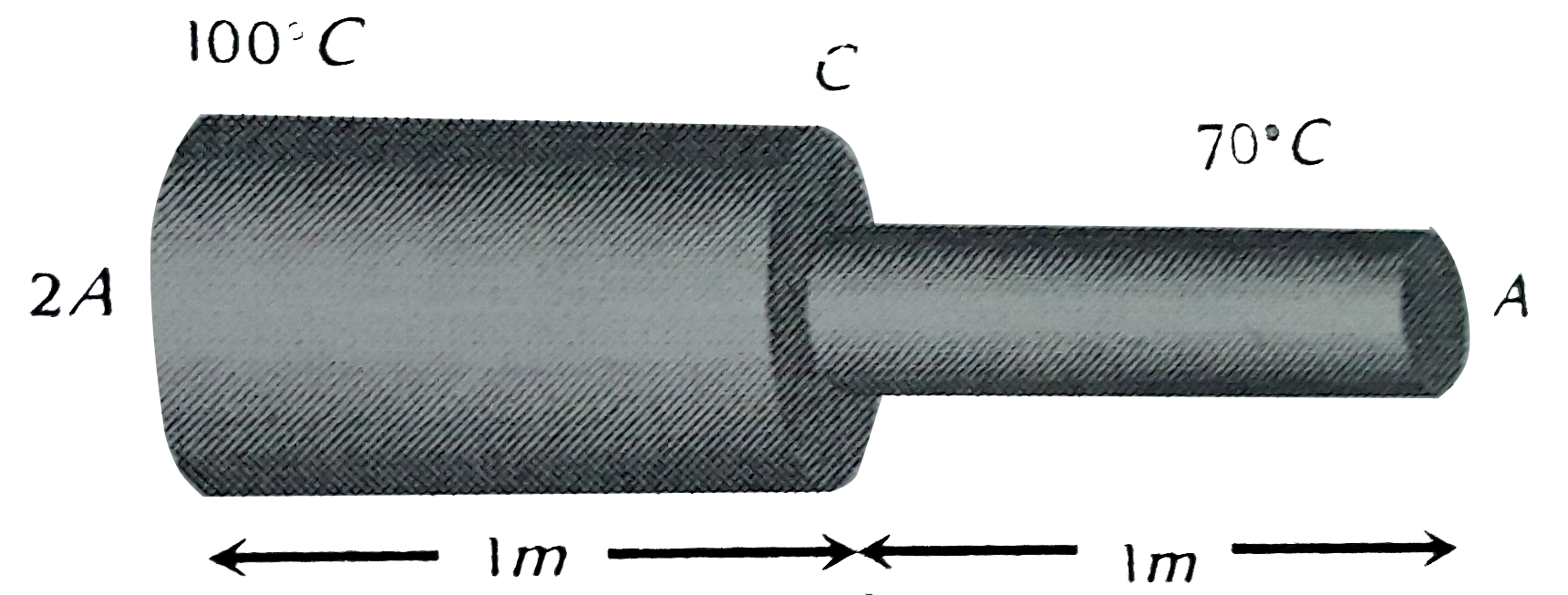Complete Solutions to Conduction of chapter TRANSMISSION OF HEAT of Class 11 book with complete answers and questions
| Class 11 | PHYSICS |
| Chapter | TRANSMISSION OF HEAT |
| ERRORLESS | Conduction |
| Number Of Questions | 68 |
| Academic Year | 2023-24 |
In which case the thermal conductivity increases from left to right
View SolutionWhich of the following cylindrical rods will conduct most heat, when their ends are maintained at the same steady temperature
01:00View SolutionThe heat is flowing through two cylindrical rods of same material. The diameters of the rods are in the ratio `1:2` and their lengths are in the ratio `2:1`. If the temperature difference between their ends is the same, the ratio of rates of flow of heat through them will be
02:05View SolutionTwo identical square rods of metal are welded end to end as shown in figure (i), 20 calories of heat flows through it in 4 minutes. If the rods are welded as shown in figure (ii), the same amount of heat will flow through the rods in
 01:43View Solution
01:43View SolutionFor cooking the food, which of the following type of utensil is most suitable
01:54View SolutionUnder steady state, the temperature of a body
01:36View SolutionThe coefficient of thermal conductivity depends upon
01:07View SolutionWhen two ends of a rod wrapped with cotton are maintained at different temperatures and after some time every point of the rod attains a constant temperature, then
02:36View SolutionThe length of the two rods made up of the same metal and having the same area of cross-section are 0.6 m and 0.8 m respectively. The temperature between the ends of first rod is `90^(@)` C and `60^(@)` C and that for the other rod is 150 and `110^(@)` C. For which rod the rate of conduction will be greater
03:02View SolutionThe ratio of thermal conductivity of two rods of different material is `5 : 4`. The two rods of same area of cross-section and same thermal resistance will have the lengths in the ratio
02:02View SolutionThe thermal conductivity of a material in CGS system is 0.4. In steady state, the rate of flow of heat 10 cal/sec-cm, then the thermal gradient will be
02:58View SolutionTwo rectangular blocks A and B of different metals have same length and same area of cross-section. They are kept in such a way that their cross-sectional area touch each other. The temperature at one end of A is `100^(@)C` and B at the other end is `0^(@)C`. If the ratio of their thermal conductivity is `1 : 3`, then under steady state, the temperature of the junction in contact will be
04:30View SolutionTwo vessels of different materials are similar in size in every respect. The same quantity of ice filled in them gets melted in 20 minutes and 30 minutes. The ratio of their thermal conductivities will be
03:13View SolutionTwo rods `A` and `B` are of equal lengths. Their ends of kept between the same temperature and their area of cross-section are `A_(1)` and `A_(2)` and thermal conductivities `K_(1)` and `K_(2)`. The rate of heat transmission in the two rods will be equal, if
01:57View SolutionIn variable state, the rate of flow of heat is controlled by
01:36View SolutionIf the ratio of coefficient of thermal conductivity of silver and copper is `10 : 9`, then the ratio of the length upto which wax will melt in Ingen Hauze experiment will be
01:34View SolutionThe thickness of a metallic plate is 0.4 cm. The temperature between its two surfaces is `20^(@)C`. The quantity of heat flowing per second is 50 calories from `5cm^(2)` area. In CGS system, the coefficient of thermal conductivity will be
02:39View SolutionIn Searle's method for finding conductivity of metals, the temperature gradient along the bar
01:15View SolutionThe dimensions of thermal resistance are
02:33View SolutionA piece of glass is heated to a high temperature and then allowed to cool. If it cracks, a probable reason for this is the following property of glass
01:15View SolutionTwo walls of thickness d and d and thermal conductivities k and k are in contact. In the steady state, if the temperature at the outer `T_(1)` and `T_(2)` , the temperature at the common wall is
02:44View SolutionA slab consists of two parallel layers of copper and brass of the same thichness and having thermal conductivities in the ratio `1:4` If the free face of brass is at `100^(@)C` anf that of copper at `0^(@)C` the temperature of interface is .
03:13View SolutionThe temperature gradient in a rod of `0.5 m` length is `80^(@)C//m`. If the temperature of hotter end of the rod is `30^(@)C`, then the temperature of the cooler end is
01:02View SolutionOn heating one end of a rod the temperature of the whole rod will be uniform when .
02:10View SolutionSnow is more heat insulating than ice, because
02:34View SolutionWhy are two thin blankets are warmer than a single blanket of double the thickness?
02:18View SolutionIce formed over lakes has
01:37View SolutionTwo rods of same length and transfer a given amount of heat 12 second, when they are joined as shown in figure (i). But when they are joined as shwon in figure (ii), then they will transfer same heat in same conditions in
 03:28View Solution
03:28View SolutionWires A and B have have identical lengths and have circular cross-sections. The radius of A is twice the radius of B i.e. `R_A = 2R_B`. For a given temperature difference between the two ends, both wires conduct heat at the same rate. The relation between the thermal conductivities is given by-
02:22View SolutionTwo identical plates of different metals are joined to form a single plate whose thickness is double the thickness of each plate. If the coefficients of conductivity of each plate are 2 and 3 respectively, Then the conductivity of composite plate will be
05:17View SolutionIf the radius and length of a copper rod are both doubled, the rate of flow of heat along the rod increases
02:10View SolutionThe coefficient of thermal conductivity of copper, mercury and glass are respectively `K_(c), K_(m)` and `K_(g)` that `K_(c) gt K_(m) gt K_(g)`. If the same quantity of heat is to flow per second per unit of each and corresponding temperature gradients are `X_(c), X_(m)` and `X_(g)`, then
02:17View SolutionIf two metallic plates of equal thickness and thermal conductivities `K_(1)` and `K_(2)` are put together face to face and a common plate is constructed, then the equivalent thermal conductivity of this plate will be
 03:12View Solution
03:12View SolutionThe quantity of heat which crosses unit area of a metal plate during conduction depends upon
02:56View SolutionThe end of two rods of different materials with their thermal conductivities, area of cross-section and lengths all in the ratio 1:2 are maintained at the same temperature difference. If the rate of flow of heat in the first rod is `4 cal//s`. Then, in the second rod rate of heat flow in `cal//s ` will be
02:10View SolutionTwo spheres of different materials one with double the radius and one-fourth wall thickness of the other are filled with ice. If the time taken for complete melting of ice in the larger sphere is `25` minutes and for smaller one is `16` minutes, the ratio of thermal conductivities of the materials of larger sphere to that of smaller sphere is:
04:55View SolutionThe ratio of the diameters of two metallic rods of the same material is `2 : 1` and their lengths are in the ratio `1 : 4`. If the temperature difference between their ends are equal, the rate of flow of heat in them will be in the ratio
03:06View SolutionTwo cylinders P and Q have the same length and diameter and are made of different materials having thermal conductivities in the ratio 2 : 3. These two cylinders are combined to make a cylinder. One end of P is kept at `100° C` and another end of Q at `0° C` . The temperature at the interface of P and Q is
03:29View SolutionTwo identical rods of copper and iron are coated with wax uniformly. When one end of each is kept at temperature of boiling water, the length upto which wax melts are 8.4 cm and 4.2 cm respectively. If thermal conductivity of copper is 0.92, then thermal conductivity of iron is
02:29View SolutionMud houses are cooler in summer and warmer in winter because
02:02View SolutionThe temperature of hot and cold end of a 20 cm long rod in thermal steady state are at `100^(@)C` and `20^(@)C` respectively. Temperature at the centre of the rod is
02:53View SolutionTwo bars of thermal conductivities `K` and `3K` and lengths `1 cm` and `2 cm` respectively have equal cross-sectional area, they are joined lengths wise as shown in the figure. If the temperature at the ends of this composite br is `0^(@)C` and `K^(2)//l` respectively (see figure), then the temperature `phi` of the interface is
 03:26View Solution
03:26View SolutionA heat flux of 4000 J/s is to be passed through a copper rod of length 10 cm and area of cross section `100cm^2`. The thermal conductivity of copper is `400W//m//^(@)C` The two ends of this rod must be kept at a temperature difference of
02:39View SolutionOn a cold morning, a metal surface will feel colder to touch than a wooden surface because
05:06View SolutionIn order that the heat flows from one part of a solid to another part, what is required
02:06View SolutionAt a common temperature, a block of wood and a block of metal feel equally cold or hot. The temperatures of block of wood and block of metal are
01:44View SolutionAccording to the experiment of Ingen Hausz the relation between the thermal conductivity of a metal rod is K and the length of the rod whenever the wax melts is
02:47View SolutionTemperature of water at the surface of lake is `- 20^(@)C`. Then temperature of water just below the lower surface of ice layer is
02:12View SolutionOne end of a metal rod of length 1.0 m and area of cross section `100 cm^(2)` is maintained at . `100^(@)C`. If the other end of the rod is maintained at `0^(@)C` , the quantity of heat transmitted through the rod per minute is (Coefficient of thermal conductivity of material of rod =`100 W//m-K`)
02:04View Solution
The coefficient of thermal conductivity of copper is nine times that of steel. In the composite cylindrical bar shown in Fig. what will be the temperature at the junction of copper and steel ?02:57View SolutionThe lengths and radii of two rods made of same material are in the ratios 1 : 2 and 2 : 3 respectively. If the temperature difference between the ends for the two rods be the same, then in the steady state, the amount of heat flowing per second through them will be in the ratio
02:35View SolutionA slab consists of two layers of different materials of the same thickness and having thermal conductivities `K_(1)` and `K_(2)`. The equivalent thermal conductivity of the slab is
03:28View SolutionThere are two identical vessels filled with equal amounts of ice. The vessels are of different metals., If the ice melts in the two vessels in 20 and 35 minutes respectively, the ratio of the coefficients of thermal conductivity of the two metals is
02:08View SolutionThe temperature of water at the surface of a deep lake is `2^@C`. The temperature expected at the bottom is
01:38View SolutionThe heat is flowing through a rod of length 50 cm and area of cross-section `5cm^(2)` . Its ends are respectively at `25^(@)C` and `125^(@)C` . The coefficient of thermal conductivity of the material of the rod is `0.092 kcal // m × s ×.^(@) C` . The temperature gradient in the rod is
02:16View SolutionIn the Ingen Hauz’s experiment the wax melts up to lengths 10 and 25 cm on two identical rods of different materials. The ratio of thermal conductivities of the two materials is
02:29View SolutionHeat current is maximum in which of the following (rods are of identical dimension)
01:51View SolutionTwo rods of same length and cross section are joined along the length. Thermal conductivities of first and second rod are `K_(1)` and `K_(2)`. The temperature of the free ends of the first and seconds rods are maintained at `theta_(1)` and `theta_(2)` respectively. The temperature of the common junction is
03:47View SolutionConsider a compound slab consisting of two different material having equal thickness and thermal conductivities `K` and `2K` respectively. The equivalent thermal conductivity of the slab is
02:41View SolutionTwo rods having thermal conductivity in the ratio of 5 : 3 having equal lengths and equal cross-sectional area are joined by face to face. If the temperature of the free end of the first rod is `100^(@)C` and free end of the second rod is `20^(@)C` . Then temperature of the junction is
04:13View SolutionWoolen clothes are used in winter season because woolen clothes
02:28View SolutionTwo metal cubes A and B of same size are arranged as shown in Figure. The extreme ends of the combination are maintained at the indicated temperatures. The arrangement is thermally insulated. The coefficients of thermal conductivity of A and B are `300W//m ^@C and 200 W//m^@C,` respectively. After steady state is reached the temperature t of the interface will be ......
 03:38View Solution
03:38View SolutionA cylindrical rod having temperature `T_(1)` and `T_(2)` at its ends. The rate of flow of heat is `Q_(1) cal//sec`. If all the linear dimensions are doubled keeping temperature constant, then rate of flow of heat `Q_(2)` will be
02:56View SolutionA body of length `1 m` having cross sectional area `0.75 m^(2)` has heat flow through it at the rate of `6000 "Joule"//sec`. Then find the temperature difference if `K = 200 Jm^(-1) K^(-1)`.
01:13View SolutionA wall has two layers A and B each made of different materials. The thickness of both the layers is the same. The thermal conductivity of A, `K_(A) = 3K_(B)`. The temperature different across the wall is `20^(@)C` in thermal equilibrium
03:10View SolutionA metal rod of length 2 m has cross sectional areas 2 A and A as shown in figure. The ends are maintained at temperatures 100° C and 70° C . The temperature at middle point C is
 02:40View Solution
02:40View SolutionThe ratio of the coefficient of thermal conductivity of two different materials is `5 : 3`. If the thermal resistance of the rod of same thickness resistance of the rods of same thickness of these materials is same, then the ratio of the length of these rods will be
02:40View SolutionWhich of the following circular rods. (given radius r and length l ) each made of the same material as whose ends are maintained at the same temperature will conduct most heat
01:38View Solution
Conduction questions and complete solutions for chapter TRANSMISSION OF HEAT of UNIVERSAL BOOK DEPOT 1960 PHYSICS (HINGLISH) of Class 11
